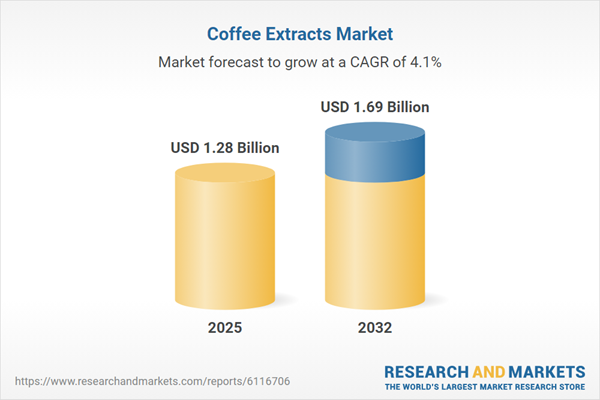Speak directly to the analyst to clarify any post sales queries you may have.
The coffee extracts market is poised for sustained growth, driven by rising demand for versatile, high-quality ingredients across food and beverage innovation. Senior executives seeking strategic insights can leverage this report to navigate evolving consumer expectations and global value chain dynamics within the coffee extracts landscape.
Market Snapshot: Coffee Extracts Market Size and Trajectory
The Coffee Extracts Market expanded from USD 1.23 billion in 2024 to USD 1.28 billion in 2025 and is projected to reach USD 1.69 billion by 2032, with a CAGR of 4.05%. This robust growth reflects increasing adoption of coffee extracts in both traditional and new product applications. Key growth drivers include the prioritization of clean-label formulations, the surge in convenience-oriented products, and expanding uses spanning bakery, beverage, dairy, and nutraceutical segments.
Scope & Segmentation
This report delivers a comprehensive analysis of the coffee extracts sector, examining opportunities and trends by key segment and geography:
- Form: Capsules, Liquid, Powder
- Caffeine Content: Decaf, Regular
- Formulation: Roasted, Unroasted
- Application: Bakery and Confectionery (Bakery Products, Confectionery Products); Beverages (Concentrates, RTD Drinks); Cosmetics & Personal Care (Hair Care, Skin Care); Dairy and Frozen Desserts (Ice Cream, Yogurt)
- Distribution Channel: Online Retail (Brand Websites, E-Commerce Platforms), Specialty Stores, Supermarket and Hypermarket
- Regions: Americas (United States, Canada, Mexico, Brazil, Argentina, Chile, Colombia, Peru); Europe, Middle East, and Africa (United Kingdom, Germany, France, Russia, Italy, Spain, Netherlands, Sweden, Poland, Switzerland, United Arab Emirates, Saudi Arabia, Qatar, Turkey, Israel, South Africa, Nigeria, Egypt, Kenya); Asia-Pacific (China, India, Japan, Australia, South Korea, Indonesia, Thailand, Malaysia, Singapore, Taiwan)
- Leading Companies: Nestlé S.A., Unilever PLC, Alchem International Pvt. Ltd, Anwel Life Sciences Pvt. Ltd., Astrra Chemicals, Botanic Healthcare, Caribou Coffee Company, Inc., Death Wish Coffee Co., Illycaffè S.p.A., J.M. Smucker Company, Keurig Dr Pepper Inc., Luigi Lavazza S.p.A., Mount Hagen, Peet's Coffee, S&D Coffee & Tea by Westrock Coffee Company, Starbucks Corporation, Tata Global Beverages, The Coca-Cola Company, The Kraft Heinz Company
Key Takeaways
- Shifting consumer focus on wellness and sustainability accelerates the adoption of coffee extracts with functional, clean-label credentials.
- Technology advancements in extraction methods are enabling manufacturers to retain nuanced flavors and optimize bioactive compound preservation.
- Brands are diversifying formats, offering both powdered and liquid solutions for bakery, RTD beverages, and dairy sectors, opening new market channels.
- Strategic partnerships, vertical integration, and specialized sourcing initiatives are enhancing differentiation and supply chain resilience.
- Regional variations are pronounced, with North America and Asia-Pacific prioritizing convenience and premiumization, while EMEA markets emphasize sustainability and provenance.
Tariff Impact: U.S. Policy Influence on Coffee Extract Supply Chains
Revised U.S. tariff measures enacted in 2025 increased complexity for coffee extract importers and producers. Elevated duties on derivatives and packaging materials have prompted companies to reassess sourcing, invest in domestic extraction, and adopt advanced scenario planning. Smaller firms face heightened cost pressures, while larger buyers negotiate long-term contracts with tariff clauses to stabilize input costs.
Methodology & Data Sources
This research integrates primary insights from interviews with executives, R&D leaders, and procurement specialists, complemented by secondary analysis of trade data, technical journals, and market databases. The segmentation structure was refined through expert consultations and triangulated with shipment and customs records for analytical rigor.
Why This Report Matters
- Enables strategic planning around product innovation, compliance, and consumer trends within the coffee extracts sector.
- Supports sourcing and procurement decisions by highlighting regulatory and tariff risks alongside regional market nuances.
- Offers actionable intelligence for targeting investments in sustainable, technology-driven growth initiatives.
Conclusion
The evolution of coffee extracts is shaped by agile innovation, regulatory landscapes, and changing consumer values. This report equips industry leaders with the insights needed to build resilient, opportunity-driven strategies within a competitive global market.
Table of Contents
3. Executive Summary
4. Market Overview
7. Cumulative Impact of Artificial Intelligence 2025
Companies Mentioned
The companies profiled in this Coffee Extracts market report include:- Nestlé S.A.
- Unilever PLC
- Alchem International Pvt. Ltd
- Anwel Life Sciences Pvt. Ltd.
- Astrra Chemicals
- Botanic Healthcare
- Caribou Coffee Company, Inc.
- Death Wish Coffee Co.
- Illycaffè S.p.A.
- J.M. Smucker Company
- Keurig Dr Pepper Inc.
- Luigi Lavazza S.p.A.
- Mount Hagen
- Peet's Coffee
- S&D Coffee & Tea by Westrock Coffee Company
- Starbucks Corporation
- Tata Global Beverages
- The Coca-Cola Company
- The Kraft Heinz Company
Table Information
| Report Attribute | Details |
|---|---|
| No. of Pages | 197 |
| Published | October 2025 |
| Forecast Period | 2025 - 2032 |
| Estimated Market Value ( USD | $ 1.28 Billion |
| Forecasted Market Value ( USD | $ 1.69 Billion |
| Compound Annual Growth Rate | 4.0% |
| Regions Covered | Global |
| No. of Companies Mentioned | 20 |









